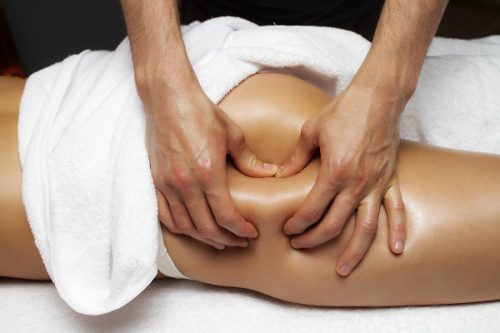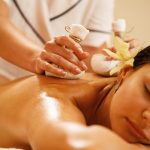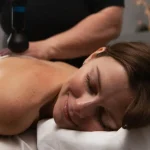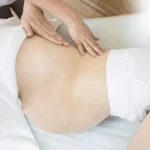Lymphatic drainage massage is more than just a wellness trend. This gentle, therapeutic technique supports your body’s natural detox system and can help you feel lighter, less bloated, and more energized. Whether you’re looking to de-puff after a long flight, recover post-surgery, or simply improve your overall wellness, this massage could be the missing link.
Also known as manual lymphatic drainage (MLD), this massage works by gently stimulating lymph flow — the process that helps your body remove waste and maintain fluid balance. In this guide, we’ll explore what lymphatic drainage is, how it works, the key benefits, and how you can try it safely at home.

Table of Contents
What Is Lymphatic Drainage Massage?
Your lymphatic system is an essential part of your immune and circulatory systems. It carries lymph — a clear fluid containing white blood cells, proteins, and waste — through a network of vessels and nodes. Unlike blood, lymph doesn’t have a pump like the heart. It relies on muscle movement, breathing, and manual stimulation to keep flowing.
Lymphatic drainage massage is a therapeutic method that uses light, rhythmic strokes to help move lymph toward key drainage points in the body, like the neck, armpits, or groin. The technique was first developed in the 1930s by Dr. Emil Vodder and has since become a widely recognized method for supporting circulation, immune function, and healing. As explained by Cleveland Clinic, this method promotes the natural flow of lymphatic fluid, helping to reduce swelling and support detox.
Unlike deep tissue or Swedish massage, manual lymphatic drainage uses feather-light pressure and slow, sweeping movements. It’s not about working deep into the muscles — it’s about helping the body do what it does naturally, just more efficiently.

Benefits of Lymphatic Massage
People turn to a lymphatic drainage massage for a wide range of reasons — from detoxification to post-operative recovery. According to Healthline, it may help relieve water retention, fatigue, and puffiness while improving circulation.
💦 Reduces water retention and swelling – Especially in legs, ankles, or after surgery
🌸 Eases bloating and puffiness – Including menstrual or hormonal bloating
💓 Boosts circulation and lymph flow – Which can help speed healing
🛡️ Supports the immune system – By moving white blood cells and clearing waste
🌟 Improves skin clarity and tone – Often leaving a healthy glow
🛌 Promotes relaxation and better sleep – As part of a regular self-care routine
For example, after flying or sitting for long periods, people often notice puffiness in their feet or ankles. A short lymphatic massage session focusing on the legs can help reduce this swelling by activating the nearby lymph nodes in the knees and groin. Similarly, those dealing with hormonal bloating (common during menstrual cycles) often report feeling lighter and more balanced after even a 10-minute abdominal massage.
How to Do Manual Lymphatic Drainage at Home
Doing manual lymphatic drainage at home can be simple and effective — if done correctly. Here are the key principles to follow:
Technique Tips:
✅ Use light pressure — Lymph vessels are just below the skin, so less is more
✅ Move toward lymph nodes — Always massage in the direction of natural lymph flow
✅ Be slow and rhythmic — Think of gentle waves, not quick rubbing
✅ Stay hydrated — Drink water before and after to help flush the system
🛠️ Tools You Can Use:
- Jade roller or gua sha – Great for face and neck
- Dry brush – Ideal for full-body drainage before a shower
- Massage oil – Light oils like jojoba or grapeseed help with glide
- Silicone cups – Used in lymphatic cupping (advanced, optional)
Dry brushing is best done in the morning using long strokes toward the heart. It not only supports lymph flow, but also exfoliates the skin and boosts circulation. Gua sha tools are often used to contour the jawline or reduce under-eye puffiness. Silicone cups are not part of traditional MLD but can stimulate flow in areas with chronic swelling.
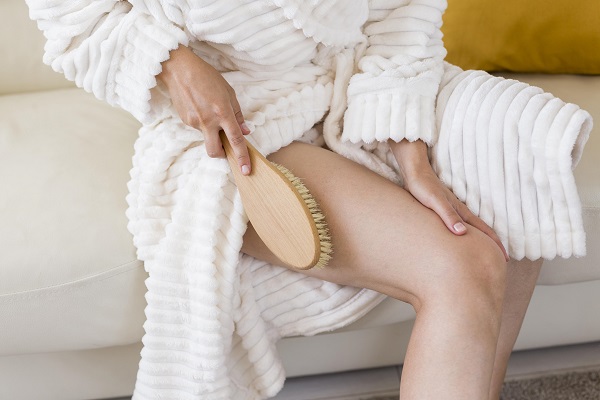
Step-by-Step: Lymphatic Drainage Massage for Key Areas
Neck & Shoulders
Start with your neck — it’s where many lymph channels drain.
- Place fingers just under the ears
- Sweep down the sides of the neck toward the collarbone
- Repeat 5–10 times, staying gentle
Arms & Underarms
- Begin at your wrists
- Use upward strokes toward the elbows and underarms
- Focus on the armpit area — a major lymph node cluster
Abdomen
- Place your hands around your navel
- Massage in gentle, clockwise circles
- Then sweep hands diagonally up and outward toward the groin
This helps stimulate intestinal lymph nodes and reduce abdominal bloating.
Legs
- Start at your ankles
- Stroke upward toward the knees
- From knees, move toward the inner thighs and groin
- Use small circles behind the knees
Face
For facial puffiness — especially under the eyes or jaw — face lymphatic massage uses outward strokes toward the ears and down the neck.
👉 Want a step-by-step guide to face lymphatic massage?
Read our full face massage tutorial here »
What to Expect Before and After
After a lymphatic drainage massage, it’s normal to experience:
- Increased urination
- Mild thirst
- Light fatigue or a deep sense of calm
- Visible reduction in swelling
- Improved skin glow and softness
Over time, regular lymphatic massage can help with persistent puffiness, boost energy, and support long-term wellness. Try it 2–3 times per week, or daily for specific recovery needs.
💬 Real Example: “Why I Swear by Lymphatic Massage for Postpartum Recovery”
“After I had my second baby, I struggled with swelling in my legs and lower abdomen that just wouldn’t go away. My midwife in Austin recommended trying manual lymphatic drainage a few times a week. I was honestly surprised at how fast it helped. I felt lighter, more relaxed, and even noticed my sleep improved. Now I do a short massage routine at home every other day — it’s my go-to for feeling reset and refreshed.”
— Jessica, 36, Austin, Texas
Who Should Get Professional Lymphatic Massage?
While at-home lymphatic drainage is effective for daily wellness, there are times when it’s best to seek help from a trained therapist. According to Memorial Sloan Kettering Cancer Center, certified lymphatic massage therapists are especially helpful for:
- Post-surgical recovery (e.g., liposuction, mastectomy, C-section)
- Managing lymphedema, especially in cancer survivors
- Chronic swelling or circulatory issues
- Post-injury rehabilitation
If you’re unsure whether you’re doing it right — or not seeing results — one session with a professional can make a big difference.
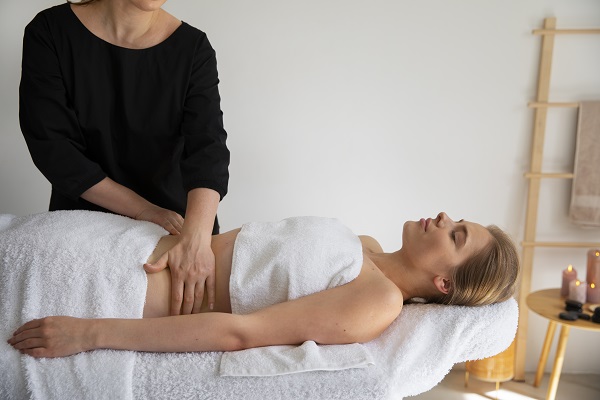
Lymphatic Massage Tools at a Glance
| Tool | Best For | Pros | Notes |
|---|---|---|---|
| Hands | All-over, gentle daily use | Always available, no cost | Most intuitive |
| Dry Brush | Legs, arms, pre-shower | Boosts circulation, exfoliates | Avoid sensitive areas |
| Jade Roller | Face, neck | Cooling, calming | Use with serum or oil |
| Gua Sha | Jawline, cheeks | Contouring, lymph release | Requires proper angle |
| Massage Cups | Deep lymph stimulation | Vacuum pressure, relaxing | Avoid bruising, not MLD |
When to Avoid Lymphatic Drainage Massage
While lymphatic massage is safe for most people, you should avoid it if you have:
🚫 An active infection or fever
🚫 Congestive heart failure
🚫 History of blood clots (DVT)
🚫 Cancer, unless cleared by your doctor
🚫 Recent surgery without medical approval
Always consult a healthcare provider before starting any new therapy, especially if you have a medical condition.
👉 Looking for a gentler style massage that blends movement, stretching, and deep relaxation? Discover the healing power of traditional Thai massage—perfect for improving flexibility, circulation, and energy balance.
Final Tips for Best Results
💧 Stay hydrated — water helps flush waste from the body
🌸 Be gentle — lymph vessels are delicate
🔄 Use consistent strokes — always toward lymph nodes
🚶 Combine with movement and breathing
⏱️ Be consistent — better results come with regular practice
Whether you’re recovering from surgery, navigating hormonal shifts, or just trying to feel more balanced, lymphatic drainage massage is a low-effort, high-impact way to reconnect with your body. It’s not about quick fixes — it’s about nurturing your system gently, one stroke at a time.

❓Frequently Asked Questions About Lymphatic Drainage Massage
🔹 What does a lymphatic drainage massage do?
It helps move lymph fluid through the body, which reduces swelling, removes waste, and supports immune function.
🔹 Is lymphatic massage safe to do at home?
Yes, if you’re in good health. Use light pressure, follow the correct direction of flow, and avoid doing it if you’re sick or recovering from surgery unless advised.
🔹 Can lymphatic drainage help with weight loss?
Not directly. While it doesn’t burn fat, it can reduce water retention and bloating, which may slim your appearance and make you feel lighter.
🔹 How often should I do it?
2–3 times per week is ideal for maintenance. Daily sessions may help if you’re dealing with swelling or recovery, but always listen to your body.
🔹 Do I need tools for lymphatic massage?
No — your hands are enough. However, tools like dry brushes or rollers can enhance the experience and help with hard-to-reach areas.
🔹 Is lymphatic drainage massage good for the immune system?
Yes. The NIH explains that the lymphatic system plays a vital role in fighting infection and supporting immune balance. Regular stimulation may help it function more efficiently.
🔹 Can I combine lymphatic massage with other wellness practices?
Absolutely. Walking, deep breathing, stretching, sauna sessions, and dry brushing all pair well with lymphatic massage for enhanced detox and relaxation.
💆 Lymphatic Massage Myth: “More Pressure = Better Results”
That’s false — and potentially harmful. The lymphatic system works just under the skin, so deep pressure can actually compress the vessels and block flow. Think soft, sweeping strokes — more like brushing water, not kneading muscles.

✨ Ready to Explore More Healing Massage Techniques?
Want to build your at-home wellness routine?
✅ Explore more massage tips and self-care guides »
✅Massage for Inflammation: How Massage Therapy Helps Your Body Heal Naturally
✅Lymphatic Massage for Face: Face Massage for Puffiness and Why It Works
📖 References
Cleveland Clinic. Lymphatic Drainage Massage. Updated April 25, 2023.
A medically reviewed overview of how lymphatic massage works, its benefits, and precautions.
Healthline. Lymphatic Drainage Massage: What It Is and How to Do It
Details common techniques and at-home tips, reviewed by medical experts.
Memorial Sloan Kettering Cancer Center. Manual Lymphatic Drainage
Provides guidance for post-surgical lymphatic drainage, including for lymphedema patients.
National Institutes of Health. The Lymphatic System (via NCBI Bookshelf)
A deeper look at how the lymphatic system functions, from a scientific/clinical perspective.
Journal of Clinical Medicine. Effects of Manual Lymphatic Drainage in Patients with Lymphedema: A Systematic Review
Clinical data supporting the effectiveness of MLD in lymphedema management.
⚠️ Disclaimer:
This article is for informational purposes only and does not constitute medical advice. Always consult with a licensed healthcare provider or certified massage therapist before beginning any new treatment, especially if you have pre-existing health conditions or concerns.

